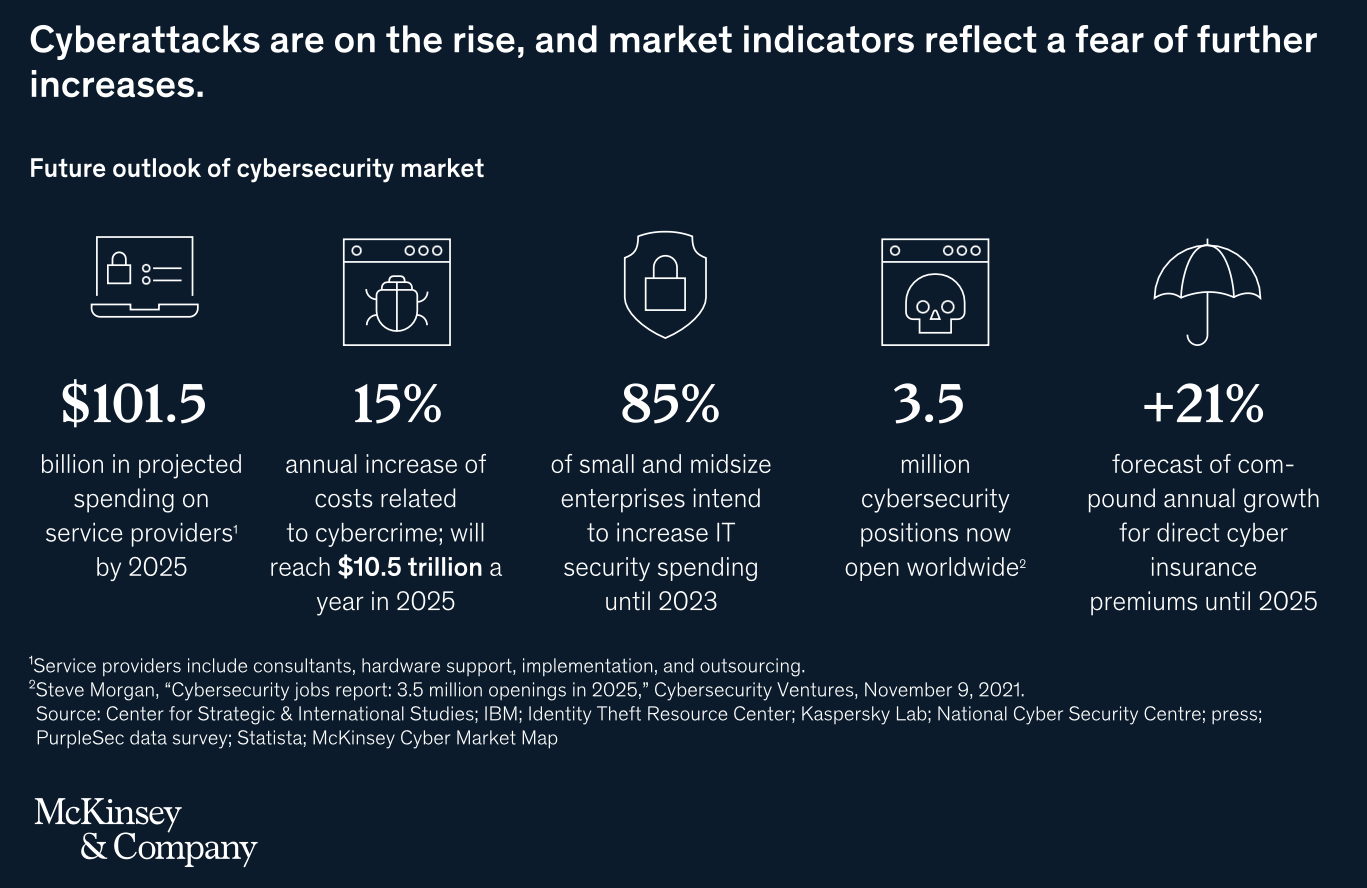In today’s digital world, the importance of cybersecurity cannot be overstated. With an exponential rise in cyber threats and attacks, organizations must constantly fight to protect their valuable data and systems. In recent years, Artificial Intelligence (AI) has become a pivotal ally in bolstering cybersecurity defenses, empowering organizations to stay one step ahead of cybercriminals.
Challenges to Cybersecurity
Cybersecurity itself presents unique obstacles, including the vast attack surface, the staggering number of devices within organizations, numerous attack vectors, a scarcity of skilled security professionals, and the overwhelming amount of data that exceeds human-scale processing capabilities.
As cyberattacks become increasingly complex, machine learning and AI technologies offer the potential to outpace malicious actors by automating threat detection and response. According to McKinsey & Company, 85% of small and midsize enterprises increased IT security spending this year.

Mitigating these challenges necessitates continuous innovation, heightened awareness, collaborative efforts and substantial investment in robust cybersecurity measures. Leveraging AI can help overcome these hurdles and enhance defense mechanisms against evolving threats.
Revolutionizing Cybersecurity Through AI
Top-performing AI adopters illustrate the potential for AI technology to transform cyber defense operations. By harnessing the capabilities of machine learning and advanced algorithms, AI has significantly improved cybersecurity threat protection.
Vulnerability Management
Vulnerability management is a continuous, proactive, and often automated process that keeps computer systems, networks, and enterprise applications safe from cyberattacks and data breaches. It can be difficult to find abnormal network assets using conventional detection mechanisms, given the sheer number of assets in a typical network and the susceptibility to a high frequency of false positives. AI can be employed in the vulnerability management process to help reduce the number of false positives by essentially detecting prior misdetections. Vulnerability scanners conduct a series of tests against systems and networks, looking for common weaknesses or flaws. These tests can include attempting to exploit known vulnerabilities, guessing default passwords or user accounts, or simply trying to gain access to restricted areas. Due to the nature of machine learning, as the experience of an AI system increases over time, its ability to accurately predict false positives versus legitimate vulnerabilities will improve.
Advanced Malware Detection & Prevention
Anyone can fall victim to a malware attack - especially in our increasingly digital world. Malware are malicious applications or code that damage or employ trickery to impede and disrupt the normal use of endpoint devices. Cybercriminals target organizations and civilizations alike through many forms of malware, including phishing, spyware, adware, viruses, ransomware, and tech support scams, just to name a few.
AI-based solutions use machine learning algorithms to detect and respond to both known and unknown malware. Unlike humans, AI never tires, stays on top of constant changes, can scale to handle very large datasets, and can automatically generate baseline models of normal behavior. This proactive approach enhances the accuracy of malware detection, accounts for abnormal behavior in real-time, and significantly reduces false positives, ensuring that cyber threats are mitigated before they can cause substantial damage.
Rapid Incident Response & Remediation
In the event of a data breach, AI enables organizations to mount swift and effective incident response efforts. AI-based incident response platforms automate various stages of breach response, including breach identification, containment, and remediation. By autonomously analyzing and correlating vast datasets, AI systems provide security teams with actionable insights through advanced algorithms and machine learning techniques, facilitating prompt decision-making and enabling timely identification, response, and mitigation of breaches, minimizing their impact on the organization.
According to IBM’s 2022 Data Breach Report, 83% of organizations have had more than one data breach and 60% of those breaches led to price increases passed on to customers. Cybersecurity attacks come with a hefty price tag, costing $4.35 million per attack on average. However, breaches at companies with fully deployed security AI and automation systems cost $3.05 million less than breaches at organizations without automated cybersecurity defense mechanisms.
By leveraging historical data and patterns, AI models can provide valuable insights into the root cause of an incident, facilitating effective remediation strategies. Algorithms continuously learn and adapt to evolving threats, allowing for proactive recognition of emerging attack vectors and vulnerabilities, reducing the overall impact of cybersecurity breaches and minimizing downtime and financial losses for organizations. Integrating AI into incident response processes significantly enhances the efficiency and effectiveness of cybersecurity operations, helping organizations stay one step ahead of malicious actors in the ever-changing threat landscape.
Improved Operational Efficiency
AI-powered security platforms offer a centralized and streamlined approach to security operations, offering a comprehensive view of the organization's security structure. Through the integration and correlation of data from various sources, AI facilitates the effective management of security incidents, threat intelligence, vulnerability assessments, and access controls. This consolidation of security functions and data not only improves operational efficiency but also mitigates the complexity and expenses associated with overseeing multiple security tools and systems. By leveraging AI, organizations can gain actionable insights and make informed decisions based on a holistic understanding of their security landscape.
Conclusion
As the threat landscape evolves, AI will remain a critical tool in the battle against cyber threats. By integrating AI into cybersecurity efforts, organizations can allocate their resources more effectively and detect and respond to threats in real-time, enhancing overall data security.
Discover how enterprises are leveraging next-generation MLOps platforms to democratize, operationalize, and unlock the full potential of AI by downloading our free eBook, Cost Savings And Business Benefits Enabled By Azure Machine Learning.


.png)

.png)